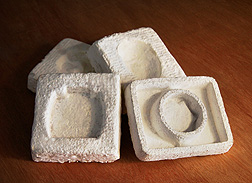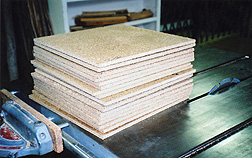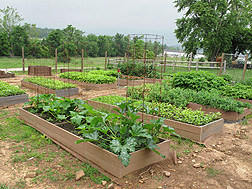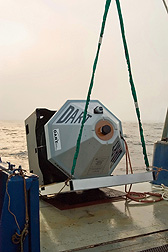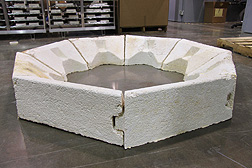Biodegradable Packaging From Cotton Waste
|
|
Summer flip-flops, garden planters, paver stones, and outdoor decking actually have something in common. If based on work conducted by Agricultural Research Service engineer Greg Holt and colleagues, all of these products can be made from agricultural waste and would biodegrade nicely.
Holt is working on a wide variety of composite materials using waste such as cotton burs, cotton seed hulls, cornstarch, gypsum, kenaf, flax, switchgrass, and wheat straw. He is with the ARS Cotton Production and Processing Research Unit in Lubbock, Texas.
One of Holt’s recent projects is providing a type of biomass that is just right for use with a new process that literally grows custom packaging material. The process involves combining cotton gin waste and fungi inside a cast, called a “tool” where the two ingredients become one, resulting in a spongy-looking material similar in appearance to polystyrene foam. The custom-shaped end product is providing a cost-effective “green” alternative to extruded polystyrene foam packaging—an estimated $2 billon market. Products include custom packaging that protects, for example, computers and other breakables during shipping.
Holt’s industry partner—New York-based Ecovative Design—developed the patented method that uses fungi as a workhorse. The technology uses the fungal growth stage, called “mycelium.” First, woody cotton waste is blended, pasteurized, and embedded into a customized cast tool. Then, the tool is injected with the fungus. The mycelium grows onto, in, and around the cotton waste, eventually forming a new, consistently textured, solid mass. Once the tool is opened, a custom-shaped bio-package emerges that is then put into a kiln-like oven, where the live fungi are killed.
“The final formed protective package insulation is biodegradable, compostable, and flame retardant, yet it has the cushioning strength of synthetic packing material,” says Holt. Ecovative Design is manufacturing these cost-competitive packaging parts for their corporate clients, including Dell, Steelcase, Crate & Barrel, and others.
|
|
Which Waste Works Best?
In a test of types of gin waste, the lab evaluated the physical and mechanical properties of six different cotton-byproduct blends as a substrate for fungal colonization to manufacture the molded packaging materials. “We wanted to learn which ones met or exceeded the same characteristics of extruded polystyrene foam,” says Holt.
The six proprietary recipes consisted of cottonseed hulls, gypsum, or cornstarch blended with two sizes of cotton burr particles—fine or coarse. Each blend was then inoculated with a single fungus using two different inoculation methods, grain and liquid, for a total of 12 treatments.
The 12 treatments were evaluated for numerous physical and mechanical properties. Overall, the treatments tested well, and the results indicated that the blend and inoculation method needed are based on the end use of the product. “The materials are water resistant, but they degrade into organic matter on sustained contact with water or soil,” says Holt.
The study was published in September 2012 in the Journal of Biobased Materials and Bioenergy.
|
|
A Substitute for Other Products
In another project, Holt worked with a team to evaluate agricultural waste materials that can be used for recyclable, termite-resistant particleboards and pressboards and for thermoplastics (meltable at high heat), such as outdoor decking planks.
Because wood fiber is a premium product, manufacturers would like to use recyclable agricultural waste materials in place of some of the wood fiber in composite building materials. Composite boards and planks are used in nonstructural applications. Previous laboratory-scale research had shown that waste from cotton production holds great potential as a fiber filler, but the team wanted to test the products on a commercial scale.
The process of ginning seed cotton generates a significant amount of waste—as much as several million tons each year—which contains woody cotton burrs, stems, and other materials. For the study, Holt and colleagues Sreekala Bajwa and Dilpreet Bajwa, both with North Dakota State University, evaluated using cotton burrs and stems as filler. The study was supported by Cotton, Inc., and the test materials were manufactured at a Greenland Composites, Inc., facility in Greenland, Arkansas.
|
|
For the study, the team manufactured thermoplastic composite boards on a commercial scale with four different levels of added cotton burrs and stems. The four levels were 0 (controls, containing only wood fiber), 12.5, 25, and 37.5 percent by weight. The samples were tested for physical and mechanical properties that are relevant to nonstructural building applications, including water absorption, thickness swelling, thermal expansion, strength, hardness, and nail-holding capacity.
Testing showed that the commercial-scale samples they made by adding cotton burs and stems were comparable to the control boards containing only wood fiber. The study demonstrated overall that up to 12.5 percent of the wood fiber used in commercially available wood-plastic composite materials can be replaced or supplemented by cotton burrs and stems with no significant deterioration in mechanical and physical properties that are important for all composites.
Testing of composites produced from cotton burrs and stems showed that up to 25 percent of the wood-fiber filler could be replaced without significantly increasing the composites’ water-absorption and expansion performance, Holt says.
Bales That Come Wrapped
The researchers also added a different, but relatively new, agricultural waste to composites during the study. Some cotton producers are now using harvesters that make large, cylindrical bales of field-harvested cotton called “modules.” The modules are wrapped in a protective film made out of low-density polyethylene. These cotton module wraps (CMWs) are removed at cotton gin facilities. If not recycled, they could become an environmental burden.
The researchers demonstrated the potential of using shredded CMWs as an ingredient in thermoplastic composites. They added up to 30 percent by weight of CMW to composite boards, as a replacement for wood-fiber filler. They showed that CMWs could replace up to 30 percent of total composite weight while maintaining the physical and mechanical properties of commercially available composites used for decking, window and door components, and landscaping products.
“We want to give ginners a way to sell their wastes for value-added applications,” says Holt.
The study was published in January 2013 in Journal of Thermoplastic Composite Material.—By Rosalie Marion Bliss, Agricultural Research Service Information Staff.
This research is part of Quality and Utilization of Agricultural Products, an ARS national program (#306) described at www.nps.ars.usda.gov.
Gregory A. Holt is in the USDA-ARS Cotton Production and Processing Research Unit, 1604 E. FM 1294, Lubbock, TX 79403; (806) 746-5353.
|
|
Protecting Buoys That Protect Us
The National Oceanic and Atmospheric Administration (NOAA) has introduced its next generation of tsunami-warning buoys placed at strategic locations throughout the oceans. These buoys work together to monitor and measure tsunamis in the deep ocean, forming an array. NOAA needed a moldable, biodegradable material to keep the buoys and instrumentation from getting damaged during and after launch into the ocean.
ARS scientist Greg Holt and Ecovative, based in Green Island, New York, created a biodegradable material made from a proprietary blend of biomass substrates and cotton byproducts to cushion the buoys. NOAA’s Pacific Marine Environmental Laboratory based in Seattle, Washington, has successfully tested the new material in a variety of oceanic conditions and hopes to launch buoys wrapped in the protective cushioning in the near future.
|
|
The technology was developed by Ecovative with support from Holt, research leader of the ARS Cotton Production and Processing Research Unit, a division of the Cropping Systems Research Laboratory in Lubbock, Texas.—By Rosalie Marion Bliss and Peggy Greb, ARS.
"Biodegradable Packaging From Cotton Waste" was published in the November/December 2013 issue of Agricultural Research magazine.







